ISSN 2348-1196 (print)
International Journal of Computer Science and Information Technology Research ISSN 2348-120X (online) Vol. 10, Issue 3, pp: (12-19), Month: July - September 2022, Available at: www.researchpublish.com

ISSN 2348-1196 (print)
International Journal of Computer Science and Information Technology Research ISSN 2348-120X (online) Vol. 10, Issue 3, pp: (12-19), Month: July - September 2022, Available at: www.researchpublish.com
1University of Granada, Spain
DOI: https://doi.org/10.5281/zenodo.6806815
Published Date: 07-July-2022
Abstract: The purpose of this study is to explore the different behaviors that young people develop on the Internet, and how they can be risky attitudes. In this way, through a questionnaire, we intend to analyze their attitudes and points of view in order to establish comprehensive keys that will allow educators to dynamize effective actions to respond. This study also aims to provide guidelines for parents in the face of the challenge of educating in a virtualized world, and also to serve as a product of visibility of a situation that is of increasing concern and which has not yet been able to bring educators and the educational community together. After the presentation of the results, we extend our article by giving a series of conclusions on what has been collected.
Keywords: education, online, young people, educational keys.
Advances in Information and Communication Technologies (ICT) have considerably modified society, providing opportunities in the field of communications, but also generating risks derived from their misuse. For some years now, protocols for action, pedagogical proposals and legislative changes have been legislative changes. The aim is to make parents and caregivers aware that buying a device and subscribing to the service with an Internet company is not everything. It is in the use and adoption of the device where the opportunities and the prevention of risks really lie. If you do not have the competencies, you cannot adequately guide those who are growing up with technology. This accompaniment cannot only be based on restriction, but must be more active, proactive and suggestive, and provide tools for children and young people to develop them and young people to develop (Payton et al., 2000)
Education starts at home and at an early age, children know how to handle devices, but it is everyone's responsibility to teach them and protect them. Providing education is not reduced to allowing access to technology, here parental mediation is the one that marks the different. Villanueva (2018) emphasizing the problematic use of the internet and the use of information and communication technologies (ICT) in adolescent population, as well as the main risks to which they are exposed (cyberbullying, sexting, etc.) in the research "Risks and problematic uses of the internet in adolescents", It addresses aspects related to technological devices that allow access to the internet (cell phone, Tablet, laptop, indicating prevalence, motivations for use, as well as the main risks and inappropriate uses associated with ICT. In this sense, it is observed that cell phone devices are the most used, also showing an accessibility and adaptation to any context that makes them difficult for the application of restrictive mediation strategies by parents (Chawla & Cushing, 2007).
Among the main individual risk factors for inappropriate use of the Internet, the research highlights life dissatisfaction, poor group cohesiveness and family support, tendency to introversion, negative thoughts, discomfort with real social relationships and identity conflicts. On the other hand, easy access to the network, the possibility of anonymity and family factors such as poor family functioning and social support are also relevant. The research emphasizes the importance of promoting preventive strategies at the family and school level that promote an adequate use of the Internet and the reduction of the risks associated with social networks (Madell & Muncer, 2007).
ISSN 2348-1196 (print)
International Journal of Computer Science and Information Technology Research ISSN 2348-120X (online) Vol. 10, Issue 3, pp: (12-19), Month: July - September 2022, Available at: www.researchpublish.com
In short, the aim is to provide educational agents, starting with the family, with a series of guidelines aimed at promoting a better psychosocial and family adjustment in adolescents, and to enhance the processes of maturation and autonomy, favoring appropriate decision-making in relation to the use of ICTs.
Based on the aforementioned research, it is clear that children and adolescents are unaware of the dangers associated with the misuse of the Internet and social networks, among which the most common are cyberbullying, sexting and addiction; nor do they have an in-depth knowledge of the new technologies, as is commonly believed; and consequently, the fear of both parents and caregivers of being trained in the basic aspects necessary to carry out prevention tasks makes no sense. Cell phone devices are the most widely used, due to their easy accessibility and adaptation to any context, making it more difficult for parents to apply restrictive prevention strategies. Thus, it is becoming increasingly necessary to implement lines of action aimed at preventing inappropriate or problematic use of ICTs in children and adolescents, where the main actor will always be the family, but also with a broad responsibility and participation of educational institutions (Bryce & Fraser, 2014).
In this paper we intend to analyze through a series of questionnaires given to a population with certain characteristics, how social networks affect young people, what vision they have about them, how and to what extent they use these resources in their daily lives, among other aspects that I will gradually present throughout the analysis of these same.
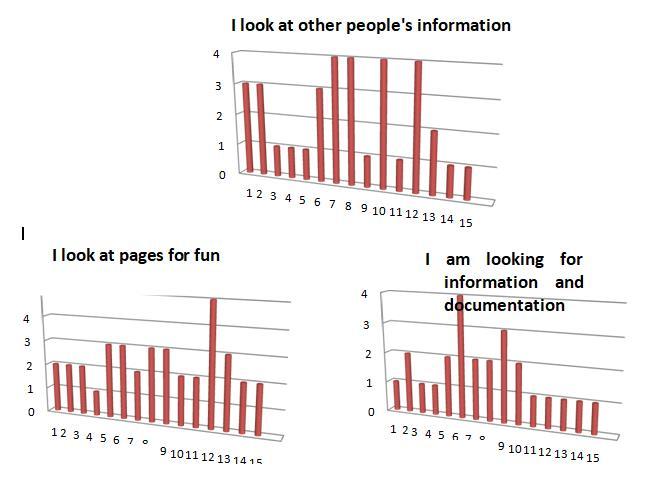
The population to which I direct my analysis is between 16 and 17 years of age, all of them students, most of them in high school. They come from a village in Jaén.
Next, we analyse what are the main characteristics of these individuals in terms of the subject to be investigated. This analysis will consist of 4 main sections, just as the questionnaire itself presents it.
The first section "Overview of uses" of the questionnaire aims to examine how users make use of the Internet and what are their most frequent actions and behaviours in this area. We can observe by means of the proposed graphs, the result of the individualized analysis of each subject (which I will call by numbers from 1 to 15) different characteristics of the analyzed users.
In this section, the degree of use will be evaluated as follows:
TABLE I: ITEMS
ISSN 2348-1196 (print)
International Journal of Computer Science and Information Technology Research ISSN 2348-120X (online) Vol. 10, Issue 3, pp: (12-19), Month: July - September 2022, Available at: www.researchpublish.com
In the items "I look at pages for fun", "I look at other people's information" and "I look for information and documentation", we can see that most users have scores close to 1 and 2, so we are dealing with a group that regularly uses the Internet to access information of interest to them, either for work or, on the contrary, for recreational purposes. Above all, this can be seen in graphs 1 and 2, in which there is almost a majority of common scores. In graph 3, these data are more varied. Speaking of recreational character, we offer another representation of how the young respondents use online games. In this case there are two high scores, 2 and 4, so there are half of the respondents who do use online games in their free time, while the other half has never played this type of recreational resource.
In terms of sharing and exposing our interests and personal issues, the online spaces most used by adolescents are usually blogs and websites. We can group the items "I upload photos, videos, etc...", "I upload blogs, websites...", and "I maintain my own website, blogs..." in order to obtain valuable and complete information about these subjects and the use of these networks. We can see that in this case, this group of young people has a really low score, in which the average ranges between 3 and 4, so they are not very prone to share or upload any kind of document to these platforms, although sometimes they do.
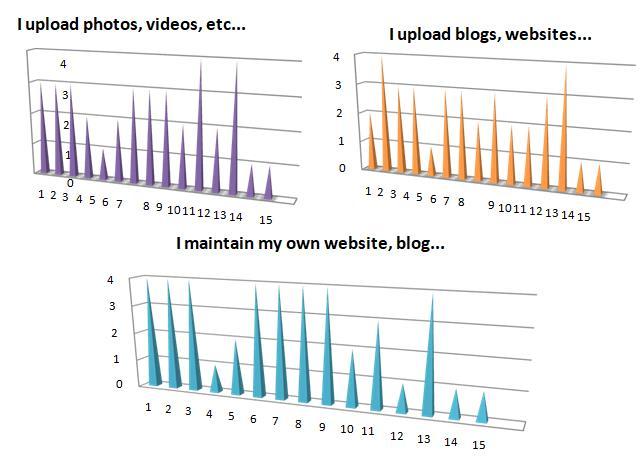
With respect to how the subjects participate in forums and other spaces in which the presentation of ideas, data of interest, among other aspects, is proposed, the students have offered very varied scores, with a significant predominance of medium and medium-low. Analyzing the items "I actively participate in forums", "I share/forward information and news from others" and "I share information and opinions with others", we can see that there is a mostly active participation, although perhaps not very high. The question in which the subjects tend to participate more occasionally is that of forums, and in which they do show more involvement is in sharing information and opinions with others, but in a general way, not necessarily making use of a specific Internet space.
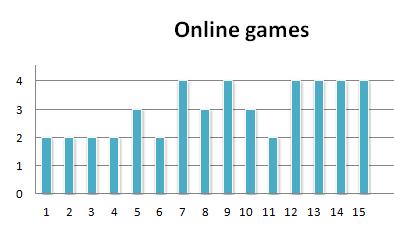
ISSN 2348-1196 (print)
International Journal of Computer Science and Information Technology Research ISSN 2348-120X (online) Vol. 10, Issue 3, pp: (12-19), Month: July - September 2022, Available at: www.researchpublish.com
Source: Self elaboration
Another interesting topic of analysis is the self-assessment of the surveyed subjects themselves in relation to the time they spend daily on the Internet. For this purpose we will use these measurement values:
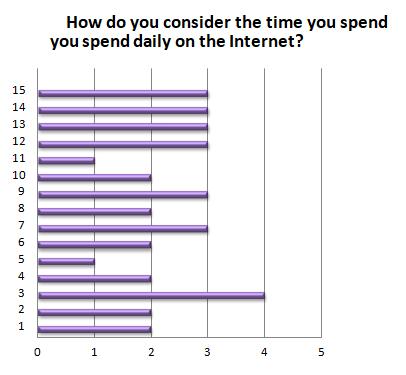
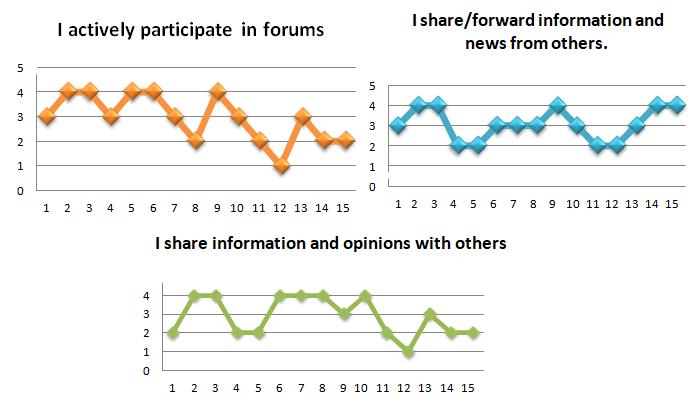
0 NS/NC 1 Clearly excessive 2 Somewhat excessive 3 The right thing to do 4 Somewhat scarce 5 Clearly scarce
In this case, the scores generally oscillate between 2 and 3, which means that almost the majority of the subjects consider that they use the Internet on a daily basis, with two other subjects who believe that they use it frequently and therefore excessively, therefore excessive.
Source: Self elaboration
This leads us to consider that the Internet is part of young people's lives and that it is a familiar resource in their daily lives. At the same time, these data reveal that the subjects themselves qualify its use in many cases as "excessive or somewhat excessive", which could be a problem.
ISSN 2348-1196 (print)
International Journal of Computer Science and Information Technology Research ISSN 2348-120X (online) Vol. 10, Issue 3, pp: (12-19), Month: July - September 2022, Available at: www.researchpublish.com
Source: Self elaboration
Similarly, the following graph analyzes the self-assessment that the subjects establish regarding the use of social networks. As can be seen, there is a majority of people who believe that their use is somewhat excessive, with only one subject not using them on any occasion.
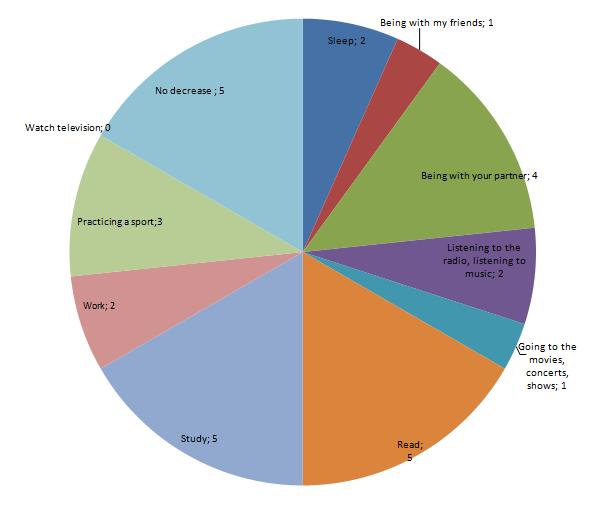
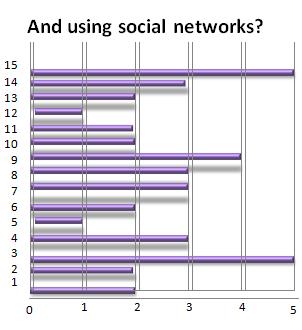
Finally, the following circular representation makes us visualize in an easier way the opinion that the subjects present about the decrease of time of different activities due to the use of social networks.
Source: Self elaboration
The activities most affected are: Studying, Reading and Being in a Couple, while another large sector is of the opinion that no activity has decreased due to the use of these networks.
B. Perspectives on social networks and their management in education
In this section, "Perspectives on social networks and their management", we will first analyze which are the most important ideas and those that are most important for the subjects of the influence of social networks in society.
ISSN 2348-1196 (print)
International Journal of Computer Science and Information Technology Research ISSN 2348-120X (online) Vol. 10, Issue 3, pp: (12-19), Month: July - September 2022, Available at: www.researchpublish.com
First of all, most of the people surveyed consider that social networks "make you stop doing other fun or necessary things", so it can be said that they consider social networks as a way of distraction. On the other hand, and in the same way, the majority of young people believe that social networks make it significantly easier to establish relationships without commitment. These two ideas are the most voted by this group of subjects, although they are followed by three others, also highly valued: "They make people more efficient and competent", "They isolate people" and "They make relationships more impersonal". Thus, a very cold perspective of the person and his or her interpersonal relationships in this environment is provided. As the following representation indicates, most users "rarely" delete their contacts from social networks, but "occasionally" add contacts to their networks.
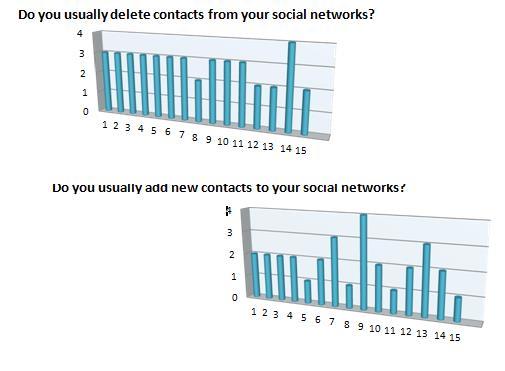
And as can be seen in the last representation, the top three reasons why they may remove an individual from their contact list are: "If he or she makes inappropriate or off-color comments", "If I argue with him or her" or "If he or she has tastes or hobbies that are very different from mine".
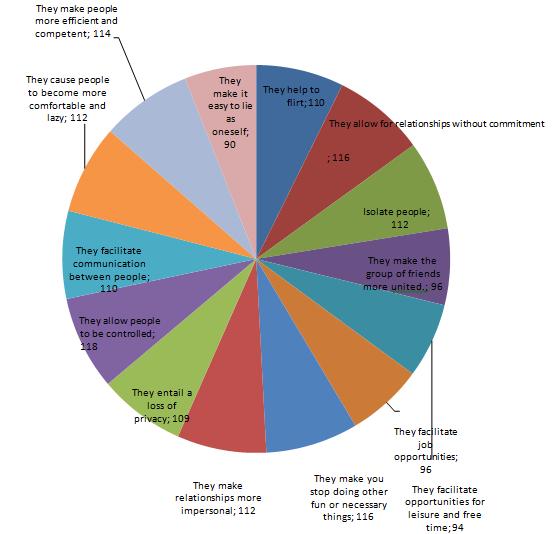
ISSN 2348-1196 (print)
International Journal of Computer Science and Information Technology Research ISSN 2348-120X (online) Vol. 10, Issue 3, pp: (12-19), Month: July - September 2022, Available at: www.researchpublish.com
Source: Self elaboration
On the other hand, the main reasons for adding a new contact according to our subjects are mainly the following: "That I meet him/her one day and like him/her", "That I am introduced to him/her by someone I trust" and "That I like him/her physically". This means that the majority of the subjects do not add someone they do not know personally, and this criterion is an important reason for selection.
The purpose of this study was to study the behavior of young people and adolescents with respect to cell phone use. The findings indicate that parents are the first teachers and the most influential in children's lives. That is why it is so important for parents to develop and maintain strong links with their children's schools. When parents and families are involved in schools, children tend to excel more and their opinions of school are more positive. For children to succeed in school, parents and families must be actively involved in their children's learning. Indeed, many scientific studies show that what the family does is more important to children's success in school than the family's income level or the parents' level of education (Gibson & Cartwright, 2014)
The Internet is the hegemonic medium for seeking information among young people. These young people have developed and socialized in technological contexts where communication 2.0 has revolutionized the way of accessing any topic of interest or concern. Young people and adolescents recognize the importance of the Internet for searching for health information, especially because it is easy to access, free of charge, because they find huge amounts of information, because it is a personalized access and because it guarantees anonymity. We found that information searches by young people and adolescents are disorderly, lacking an organized structure other than that offered by Google. Group participants find it difficult to remember the names of the pages they visit or have visited. These pages are not always the same; there is no fidelity of use. Depending on the information they are looking for, Google itself recommends one page or another. Age is a determining variable in many cases when talking about health behavior among young people and adolescents. This explains why young people between 21 and 24 years of age mainly look for health information on the Internet, with parents, teachers and doctors taking a back seat. Thus, for the digital generation, the Internet is a source for initial information, but never definitive or valid if it is not consulted later with a specialist. Girls and boys share an interest in searching for information on the Internet, especially on topics such as healthy eating, exercise and mental health, which is important because it contributes to physical and psychological well-being during this period and reduces the likelihood of the appearance of nutrition-related chronic diseases in adulthood (Davidson & Martellozzo, 2013; Wilska, 2003)
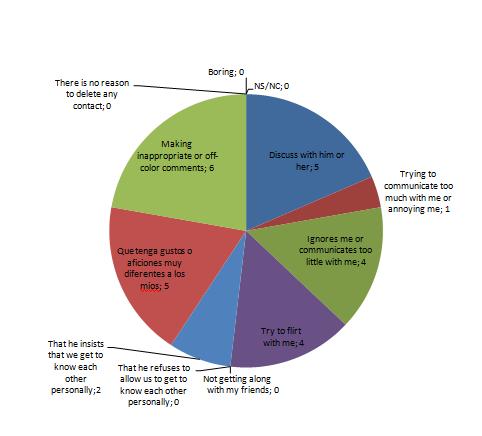
ISSN 2348-1196 (print)
International Journal of Computer Science and Information Technology Research ISSN 2348-120X (online) Vol. 10, Issue 3, pp: (12-19), Month: July - September 2022, Available at: www.researchpublish.com
[1] Payton, J. W., Wardlaw, D. M., Graczyk, P. A., Bloodworth, M. R., Tompsett, C. J., & Weissberg, R. P. (2000). Social and emotional learning: A framework for promoting mental health and reducing risk behavior in children and youth. Journal of school health, 70(5), 179-185.
[2] Chawla, L., & Cushing, D. F. (2007). Education for strategic environmental behavior. Environmental education research, 13(4), 437-452.
[3] Madell, D. E., & Muncer, S. J. (2007). Control over social interactions: an important reason for young people's use of the Internet and mobile phones for communication?. Cyberpsychology & behavior, 10(1), 137-140.
[4] Bryce, J., & Fraser, J. (2014). The role of disclosure of personal information in the evaluation of risk and trust in young peoples’ online interactions. Computers in Human Behavior, 30, 299-306.
[5] Gibson, K., & Cartwright, C. (2014). Young people's experiences of mobile phone text counselling: Balancing connection and control. Children and youth services review, 43, 96-104.
[6] Davidson, J., & Martellozzo, E. (2013). Exploring young people's use of social networking sites and digital media in the internet safety context: A comparison of the UK and Bahrain. Information, Communication & Society, 16(9), 1456-1476.
[7] Wilska, T. A. (2003). Mobile phone use as part of young people's consumption styles. Journal of consumer policy, 26(4), 441-463.